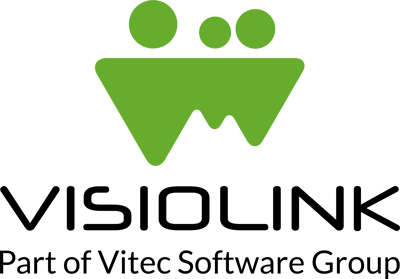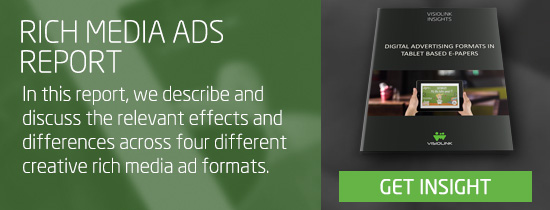In this blog post you have the possibility to read the transcript of our latest webinar on rich media ad interstitials. You can offer your advertisers a product for your e-paper that will make readers stop in their tracks and interact with the message - in surprising high numbers.
— START OF TRANSCRIPT —
We have two people here today, myself, Lars Ørhøj, I’m the Chief Marketing Officer here at the Visiolink, and with me today I have Jakob Mandrup, who is our Business Development Manager in the company. And I think he’s going to present some quite interesting things, items for you today regarding rich media ads in the e-paper, especially on the tablet platform, both based on something in regards to products, but also in regards to some of the research Jakob has been part of during the last couple of months - oh, actually quite a lot more time.
We are really looking forward to present this material as this is the first time we’re going to present it. As some of you know, we’ll present the report that is some of the basis of this webinar session today. This report is available now today on our website. Jakob will come back to that later in the session.
But as the topic today is digital ads in the e-paper, we thought it could be interesting here to start with a question, a question to you. On your screen, you should be able to see a question. And we just wanted to have an input from you guys what you’re doing today if you are at a media house and you have the e-paper up there – could be a Visiolink product, could be a competitor product – Do you actually use digital ads today on the platform, besides the printed ads, of course, in the replica of the newspaper.
And I can see you’re already getting fast on the answers here. That’s quite interesting. Oh, but around 64% of you are saying yes, we are using other ad products in the e-paper today. So about 2/3 of you. We’re really happy to see that we have quite a lot of people today from basically all over Europe today, so I think we’ll have a great session. So I think we are getting there, where we should get started. Thank you for your answers.
We ended with 71% of you saying that you are using extra ads in the e-paper. And I think that’s a good start for this webinar because that’s really what it’s about – how we can enhance what you then already have in your products. And then about 1/3 of you who are not, well, this is really about enhancement of the ad products of today.
Again, welcome to the session, and I will hand over the rest of it. He’ll be showing a presentation here, but he will also do a few demos on his iPad, presenting some of the ad products during the session. We’ll switch back and forth from the presentation and to a direct live feed from an iPad. Welcome Jakob, and please take it over from here.

Thanks, Lars. And as Lars just said, for those of you who were here in the real beginning, my name is Jakob Mandrup. I work with business development in Visiolink and I have worked with this rich media advertising in the last six months. So I’m really excited to be able to present to you what I have. And I’m also, as Lars said, also really happy to see that so many of you guys have joined us here.
As Lars said, this is really about creating new revenue streams for us, for the media houses. But let me start you with an overview about what this webinar is about. Yeah. I have chosen to divide it into two parts.
The first part is about what we know about rich media ads in interstitials, in general, today. We have, of course, collected some statistics from our service, which I’m going to show you, but we have also carried out a study together with the University of Aarhus over the last six months, and it’s a quantitative survey with 225 respondents.
So I’m going to show you some of the results that we have from that survey also. And then the second part is about the actions, you can say, that we have chosen to take based on the findings that we have made. Here I will inform you about some new products which we’ll be launching in the beginning of 2015. So I hope that you will stay with us for both parts.
The presentation, I expect, will last around 30 minutes. And as Lars said, of course, there will be possibilities to ask questions in the end also. Let me first start by setting the scene with this light. This is the ad spending in Denmark – newspapers, locals, and weeklies – in the period from 2006 to 2012. And as you can see, it’s a significant decline from around $6 billion Danish kroner to just under $4 billion. And if we had looked at the newspapers only, it would have been an even more significant decline. So there we see a decline of around 51% during this period. And we see the same trend in other countries, in Scandinavia and northern Europe where we are working.
So, yeah, I think we can say that this is a general trend. One way to cope with this is, of course, to keep on telling that many people still read printed newspapers. This is an example from a campaign brought in a lot of Norwegian papers back in October this year. Now, the headline as you can see, maybe if you are a Norwegian joining this one, the headline is saying so we heard that you were watching this ad – and with more just below – nobody reads newspapers anymore. And then comes the text and the message. Newspaper ads are actually working. 2.9 million Norwegians read at least one newspaper every day. So keep telling that the printed papers is still a strong platform and also for advertising.
Another way, of course, is to start looking for new advertisement products. And this graph is showing the interstitials used in Visiolink e-papers. We introduced interstitials as an ad product a couple of years ago. And for those of you who are not familiar with interstitials, it’s a full-screen ad which is placed between two pages in the e-paper. So it’s a digital ad. And the media company can then choose on which pages to place the ad. As you can see, actually 222 newspaper titles have implemented the feature. A growing number of you are using it. Today we have 29 titles which are actively using it. We have some heavy users, I would say.
We have six titles which, in 2014 so far, has used it between 100 and 400 times. And then we have the majority, which have been using it between 10 and 100 times. I don’t know what the newspapers actually are charging towards advertisers for interstitials, but I know that when you can multiply it by 100, then it should start to become interesting.
One of the customers, our customer who is actually a heavy user of our interstitial, is the Swedish language newspaper, HBL, Hufvudstadsbladet, I think it’s called, based in Finland. And Fredrik Nars, who is Chief Marketing Officer at KSF Media who owns HBL, and he was one of the speakers at the Tablet Conference, at the World Publishing Expo in Berlin last year. During his presentation, he compared interstitials with normal banner ads. And his conclusions were that interstitials produce much higher reader engagement and, on average, they’re also much more clicked and the attention is much higher. And then he sums up with a statement that you can see right here. That “The e-paper interstitials has created a new way of selling ads for us. In some months, it’s even higher than our web banner sales.” So for us, this is a kind of proof of concept for the interstitials, that they are working, they have good effect and that the media houses are also able to have this as an important revenue stream.
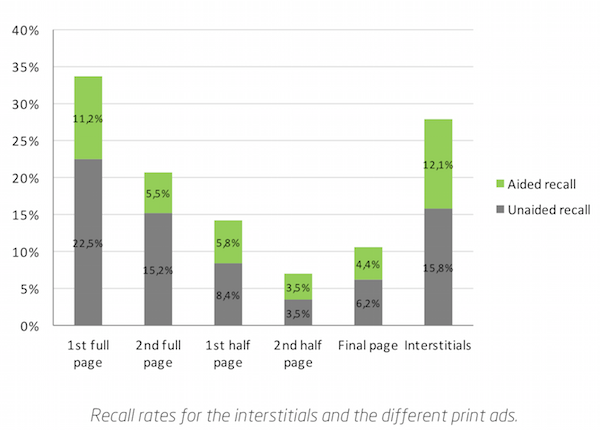
If there’s one thing that I would like you to remember from this webinar, it’s a figure of 3.6%. And that is the average CTR measured over all Visiolink’s e-papers in the last six months. And in the back you can see from the chart and the green columns that in some months it’s even higher. In October, we reached almost 5.5% of the clickthrough rates, and that is really impressive. And the numbers here are based on not just estimates.
You can say we have 7 million impressions based on 2,400 interstitials. So it’s real effect numbers, you could say. And I don’t know if you are aware about CTRs on traditional banner ads on websites, they are typically between 0.10%, 0.12%, so it’s quite a lot higher. We also did a study with the University of Aarhus at the Danish newspaper, Morgenavisen Jyllands-Posten. And we made an ad – sorry, not an add – on an app where we had inserted four interstitials for four different brands in the first section of Jyllands-Posten.
We then had each ad was in four creative brands– one static, two dynamic, and one interactive. And then we were able to configure the app so that the respondents always looks at one of each, or they were exposed to one of each creative type. Now, I’ll to show it to you here. We have chosen to have fixed placements for the ads.
So the first one should appear after page 7. Comes here. So this is one of the dynamic ads we used for the company Topas Travel. You have some pictures coming up, and you have some balloons flying on the screen. It might be a little bit not too fluent on your screen, but I can tell you here it’s working OK. You have the balloons coming over again. Then the next one we used was after page 13, where we had a static ad, in this case, from My Cruise. The next one, again, after page 19, it’s the second dynamic ad that we used where we have the text changing and we have the cartoon changing also. And then finally comes the interactive ad here, after page 25, where it’s for a Danish food catering company, Mad & Mad it’s called in Danish. And you can see the interactive elements with the arrows where you can click to get more information about the menus, and products, and so on. So that was the app that we used.
And first the respondents had 10 minutes to skim through the first section and afterwards we had then a question ad for them, also lasting around 10 minutes. So in total we had the respondents for 20 minutes and we had 225 respondents who competed the questionnaire. When the respondents had read the first section, we first asked them which ads they actually remembered.
And we both asked them with regards to the printed ads in the first session, but also with regard to the interstitials. And as you can see from the graph here, the graph confirms some of the things that we know beforehand. The two first columns are the first full and the second full-page, and then we had the first half and the second half page, and then the final page, and then the interstitials at the end.
But the closer to the front page you are of the printed ads, the better we remember them. So that’s well known to most of you. And also, the larger that the ad is, the bigger the size of the ad is, the better we also remember it. So, so far so good. In average, you can see the interstitials had a recall of 28%, while the printed ads had a recall of 17%. So that was also actually one of the significant results in the survey, that we have a far better recall of the interstitial ads than we have of the printed ads.
As you can see, it was only the first full-page ad which actually beat or had higher recall than the interstitial ad. And that was not too surprising for us because when we looked at the advertisers for the first full-page ad, it was typically large Danish supermarket chains where the recognition is close to 100%, whereas the brands that we used in our survey, it was from brands which had a recall of around 30% to 50% rather than that high number.
Some of you may be familiar with recall rates in general and noticed that the recall rates are lower than what you might have seen. And that is also to do with how we asked for the recalls. We did not show them the ads when we asked them for aided recall. We just asked them, do you remember an ad for traveling, for instance. So that’s the reason why the recall rates are around 30% rather than 50%, 60%.
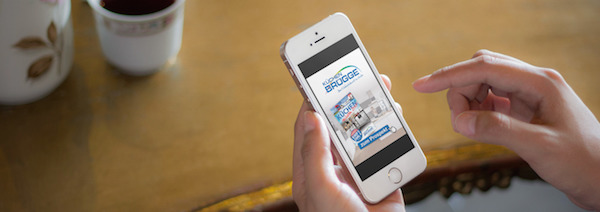
As I mentioned, we used four different creative formats– a static, two dynamic, and an interactive format– and we tracked all engagements and clicks during the survey, and that gave us these figures that you see here on the CTR. So the average CTR was highest for the interactive ads with 4.1%, and then came the static ads with 3.6%, and finally came the two dynamic ads with a somewhat lower. And I must admit that this was different to what we had expected. I would have expected the static to be lower than the dynamic and then the interactive. So our interpretation of this is, first, that you need lean forward ads where you have to engage with the ad, like in the interactive, perform better than lean backward ads.
For instance, the dynamic, where you’re just being entertained and can lean back. And then the static ad, I guess, is the well-known format for the readers, which is less dangerous and thus it’s easier for the readers to click on it. And, of course, these figures might change over time when the readers get more used to the different types of creative ads.
But, in any case, 4% in CTR on average. That also confirms the general number that we saw from our service, and still it’s quite high. For the interactive ads, we also measured the interaction rates. And for those of you who are not familiar with interaction rates, that is the number of interactions or, in this case, the number of clicks on the arrows divided by the number of impressions on the ads.
And as you can see, on average, the interaction rates had an interaction rate of 21.5%. And knowing that it’s only based on 225 respondents, it’s still an indication that the e-paper could be a suitable platform for interacting with the ads. And, actually, the interaction rate here is quite high. To my knowledge, the benchmark for interaction rates with interactive ads is typically around 5% to 10%, something like this.
We also asked the respondents about different parameters of the ads. Was the ad engaging? Was it boring? Was it entertaining? Did it give the information that the respondent expected? And so on. And we found one statement where we can say that there is a statistical significance and significant difference between the different formats. And that is actually that the dynamic and interactive ads are more entertaining than the static ads. And, of course, this may not be too surprising for you guys.
But, still, I think it’s important when we want to engage the finger of the reader and involve the reader in the ad. So that was some of the main findings from our service and from our survey, together with Aarhus University, and Jyllands-Posten.
So the key takeaways here for the first part is that a growing number of newspapers start using interstitials as part of their ad offering to advertisers. And then the figure that I really wanted you to remember, the clickthrough rates of the interstitials in the e-papers is 3.6%, measured over the last six months in all interstitials in all e-papers in Visiolink.
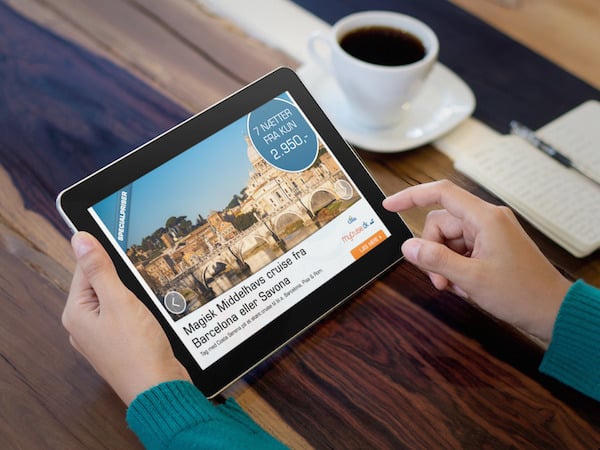
Interstitials are generally recalled much better than printed ads. Yeah Highest CTR we found on the interactive ads than on the static and then on the dynamic ads in the survey. But we also received quite high clickthrough rates in the survey from 0.6% from the lowest, up to 6.2% on the highest, and an average of the interactive on 4.1%. Dynamic and interactive ads are perceived more entertaining than static ads. And then the interaction rates average of 22% from the interactive rate, which is also quite high. So that sums up on the first part on this presentation.
I was wondering, Jakob, just one quick question. You are very happy of this 3.6% figure, and that for obvious reasons, of course, because if you compare it to other digital ads, it’s very high, my guess. I remember on that slide there you, showed us where the monthly figures, it was changing quite a lot from – I can’t remember the numbers at the moment – 2% and up to 5 point whatever percent. So did you see a large spread? You did see a large spread month by month. Could you find any reason for that, or did you also see a large spread from newspaper to newspaper?
We haven’t bit into looking at the interstitials used so far in the papers, but we can see also, just on the numbers, that there are actually quite a big variation between the newspapers also. Some are below 1%, and some are ranging up to 9%, 10% even. Which is extremely high. Which is extremely high, yes. So my take on this all, my next step into digging into these numbers would be to look for is there any cultural differences?
Or could it be that some newspapers are using more creativity in their ads, which leads to higher CTRs? Or what can be the reason? But I don’t know the reason yet, to be honest.
Well, maybe it could be, as you see in other ads, digital ads workings, that it’s maybe the frequency that is going on here, that it has an importance if you are doing it seldom, or if you have it regularly.
Sometimes you’ll see different figures on that, so maybe – Yeah, but even then I would say that there’s also differences between our heavy users. Because we have some of our heavy users, as I call them, who have used more than 100 interstitials in this year. They have clickthrough rates of 3%, 4% also. So we had some which are a little lower. So the numbers are quite new to us and we need to dig further into this, but of course we’d be happy to share my findings with you when we come more deep into this –
Yeah, and understand this correct, because even though it’s 6%, 6 is high. So, of course, it’s interesting to find the right road to success here. Yeah. Great, thank you for the clarification and, please, go on.
So as I briefly said, this was the end of the first part, and let’s move into the second part. So what has Visiolink actually chosen to do based on these findings? Well, we want to strengthen our offering within rich media ads and that’s what this second part is all about.
But let me just show you first a couple of examples on rich media ads. I just need to go to a different app here. Yeah, there it comes. So, this is a demo app that we used at the Word Publishing Expo in Amsterdam. So, some of you who visited the booth might actually have seen this before, but I just wanted to give you a picture on how rich media ads could look like. And, of course, you saw some of them in the Morgenavisen Jyllands-Posten, but the creative level there was not that high.
In that app, it was more important for us to have the comparability between the brands. So, yeah. This one is based on Haugesunds Avis, which is a Norwegian newspaper, and it contains three different rich media ads. And unfortunately, they appear randomly after some swipes.
But let’s just swipe through the paper. And then we have swiped some times, then comes the first ad. And you see this swipes in different directions and the text swipes one way and the pictures are swiping another way. So that’s one way how you can use it. I’ll just go on and see if we are so lucky that we come to another ad. It’s Christmas time, I can see, in Haugesunds. This is another ad where we have built in a picture gallery where it’s possible to, of course, to navigate between the pictures by using the arrows.
Now, my Finnish is not that strong, but if you click the right button, then there’s another picture gallery coming up where you can also move from picture to picture. You can close it here. And then the left button to the right is a kind of call to action button. You can see where we come to the website of the advertiser, where you can see the real estate that is actually for sale. So, that was just another example. And let’s just see if we can get the last one. There’s a 3D cube, we might be lucky, or we come to see this one again where it’s swiping automatically. But anyway, the last one was a 3D cube, and it was just to give you an impression of that, but we will not dwell too much more about that. Let’s go back to the presentation.
So, to offer you the best solution we have chosen to team up with a Danish creative digital agency called OnAds and, of course, also with ad serving providers, which you already know and which you may use for your websites. Until now, we integrate with Adtech and Emediate, but we are ready to add more ad serving providers when the need is there.
So if you’re interested in this and are running with DoubleClick or Adform, or another system, then let us know and we’ll take the discussion on this about how to implement that. Just coming back to OnAds. OnAds is a four-year-old digital agency which has specialized in creative formats, ad formats for all platforms, both mobile, and tablet, and PC. So they produce more than 3,500 banner ads per year and they already serve several larger Danish media groups as customers, mostly with banner ads and rich media ads for the websites.
And our partnership with OnAds goes back around six months. So we’re really excited about this and about what kind of opportunities that can be offered in this. So what we’re planning is to launch two types of products. First, a premium products where OnAds is creating tailor-made ads to the advertiser and allocate resources for that. The second one is a do-it-yourself tool, or a self-service portal where it’s actually possible for the media house, or the media company, or the advertiser to build the ad yourself, just based on text, and pictures, and videos, and so on.
Yeah. Our ambition with both products is that it should be easy to use. Booking at OnAds must be easy. And if you choose to build the ad via the self-serving tool, it should just really take a few minutes for you, if you have, of course, the input ready, being the pictures and the text and so on. Then the creative level should be high, of course. We want to engage the readers with the ads.
We want to maintain at least the 3.6%, so we need a high creative level. It should not create any hassle for you to take the ads to the ad serving system. So we will make sure that the creative text of the ads are correctly made and basically just are a kind of copy paste from the OnAds system over to the ad serving system. Hosting of the ads is, of course, taken care of, and we can provide detailed statistics on the performance of the ads. And then we aim at a low cost production set up. And, of course, again, based on that, you already had material ready, like videos, or pictures, and so on.
So, then based on that, it should be an easy add on to existing material. When it comes to the premium product, the first of the two products where OnAds is building the ads for you, OnAds has more or less the full list of the creative features. So I’ll not go through all of them here in detail, but I’ll just tell you that, more or less, anything is possible. It’s, of course, also possible to combine the different features.
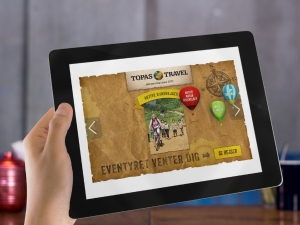
For instance, if you want a 3D cube which is turning with videos inside – that’s what I hoped to show you, but that’ll be next time – then that is, of course, also possible. For the templates, yes, we plan to launch the templates ad in the beginning of 2015. And we start with six templates in general. And as you can see, these are a swipe ad, which is actually the white one which was in the demo where the swipes went from left to right and right to left. Then we have slider ads, 3D cube ads, video ads, scratch ads, and also static ads, which is kind of easy for us to make. For phase two, we will, of course, learn from our experience with the launch of the first templates, and also listen to the feedback that we get from the media companies, you, and the advertisers.
And this means that the lists that you see to the right is, so far, a working list. And there might, of course, come changes to it, but we expect to be ready for more templates by the end of Q1 2015. And our idea is also to have demo material for each of the creative templates so that you can see what kind of ad creative formats actually you are booking into. But the idea is that, again, if you have the pictures, and the text, and maybe the video, then you insert this into this do-it-yourself tool and the tool is building the ad for you basically. And the output of this is then the creative tag that just has to be inserted into your ad system. Finally, just a little bit more about the products that we plan to launch.
As you saw from the Jyllands-Posten app that we showed you, fixed position for the ad is possible. You can also choose to have a random and then just determine that after X number of swipes then a new ad comes up. I recommend the fixed position because if the reader passes an add and wants to go back to the ad, then the ad will be there still. And it also is possible for you to combine the ad content with the editorial content that you have in your paper. So for sports companies, for instance, you place that on the sports pages, and so on.
Ads appear, of course, both in authentic and in dynamic. If you have both viewing modes, ads will appear when the reader is online. So this means that if the reader is offline, then the ad will just not be shown. Support for Emediate and Adtech, as I mentioned today, and we will include more ad systems as a need comes.
And then today we support iOS and Android platforms. And campaigns statistics are available, as we mentioned also. And then the final important thing, what is needed for you to start implementing rich media ads into your e-paper. Well, first of all, you need to have the feature called interstitials. And secondly, you need to have an integration to the mobile SDK of the ad serving provider. And if you don’t have both today, then, of course, our sales and solution delivery team can help you with that.
To sum up the second part here, we are convinced that we have an attractive ad product as your readers reach critical mass on your e-paper. As mentioned before, we already have an average CTR of 3.6% on the static ads and we are quite certain that it can become even higher as we start to include rich media features. And we also believe that we have an interaction rate which is quite interesting and that the e-paper is quite suitable for interaction.
And, of course, that has to be confirmed when we go higher in numbers and so on, but we have a good strong feeling that this is possible. So, all in all, we see this as a product with revenue potential and also with low production costs attached.
Generally speaking, if you will want to know more, the report from the study together with Aarhus University and Morgenavisen Jyllands-Posten, is just from yesterday, I think, available.
You can download it now from our website.
And we will also post some blog contributions with some of the results from the reports. So if you’re not into full report reading, then that could be a way for you to keep updates. But I strongly recommend you to go in and download it.
And then finally, we are, of course, also raising product sheets for the new advertisement products and they can also be found on our website within the next weeks, I guess.
That was actually all that I had planned for you.
And now we’ve got an overview of both the products and what, as I think probably more important, some of the effects that these products are actually capable of doing in your engagement of the readers. If you need Jakob’s contact information, here it is, and a nice picture of the man.
Thank you.
Just to sum up, I hope you have had a beneficial 40 minutes or so here together with us and have gotten an idea of what you’re capable of with these enhanced ads in the e-paper.
As many of you as we could see at the pilots, the start, many of you already have interstitials or other kind of similar products in your e-paper. This could maybe give you some ideas of what could your next step be, how can you actually get those famous 3.6% click-through-rates on your products. You could ask yourself, do we have, at the moment, do you know what your number is? And that could probably start a good discussion at your house, I’m sure.
First of all, I would like to thank you all who participated. We are really happy to see so many people here watching these sessions. And we are definitely going to plan a new sessions, also in this area, in the ad area, as soon as possible.
I would like to thank Jakob as well, of course, of doing this presentation. That’s a small part. What’s important here is all the work you’ve been doing in the months before this presentation and all the results you have had out of this project – that enhancements and dynamics and interaction of ads actually have an effect in the e-paper. And I think that’s probably the words I’m going to bring home to me that is important of this research, these have an impact in your daily newspaper.
So, again, thank you to Jakob and thank you to everybody else. You can have a look on our website when the next webinar will be. We’ll put that on tomorrow as well. So I wish, again, to thank you for participating and wish you a great day and a great night as well.
— END OF TRANSCRIPT —

